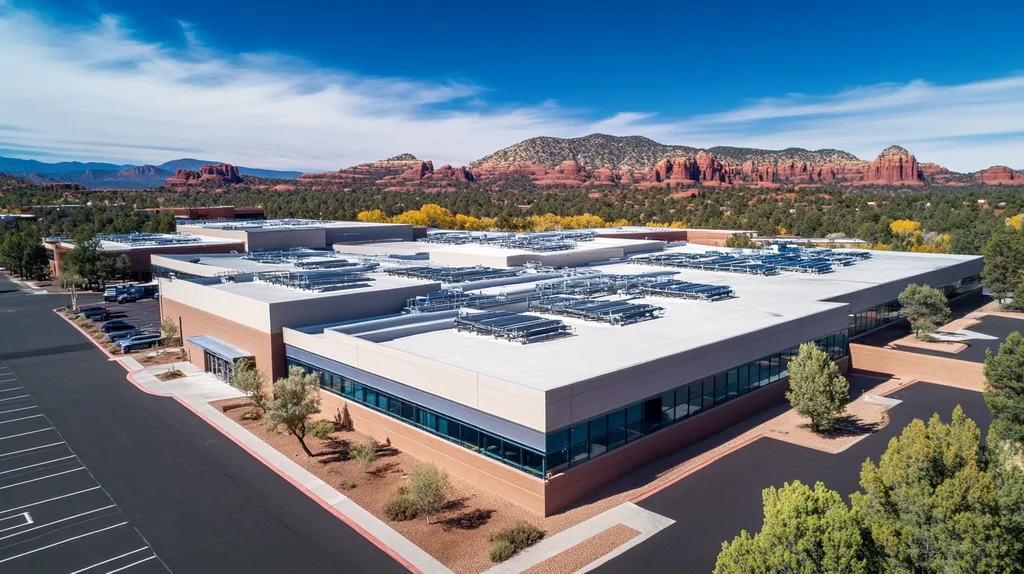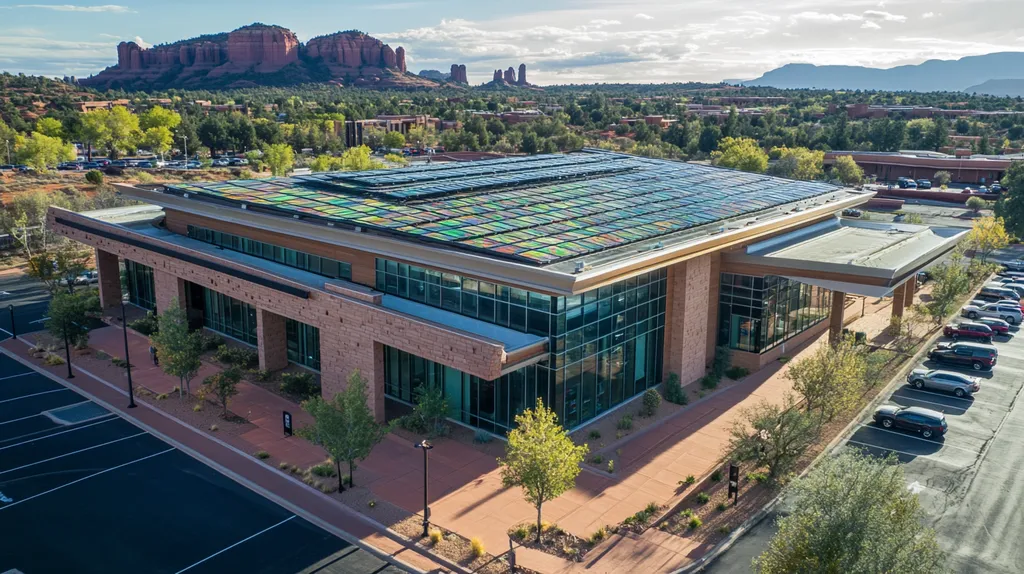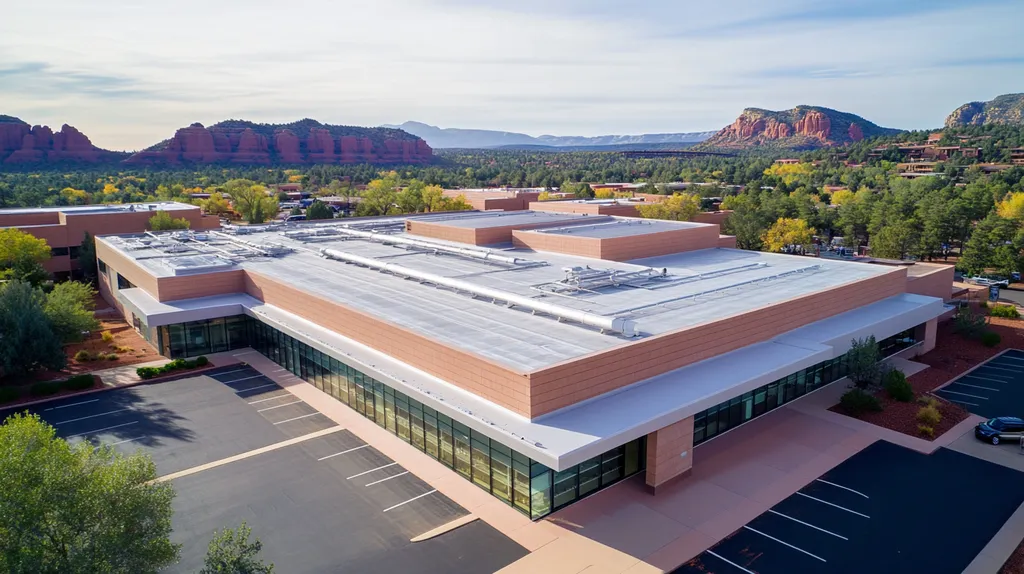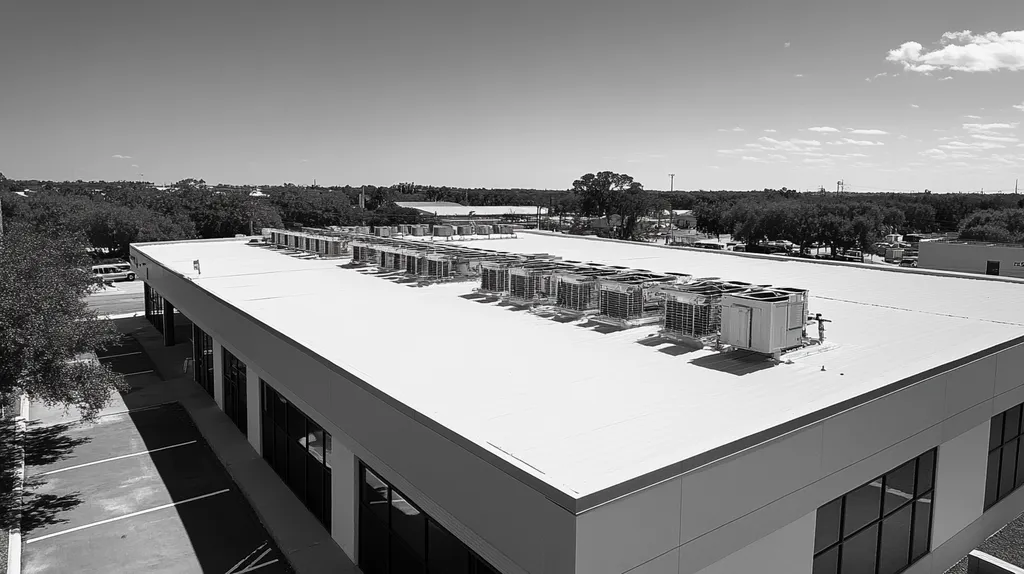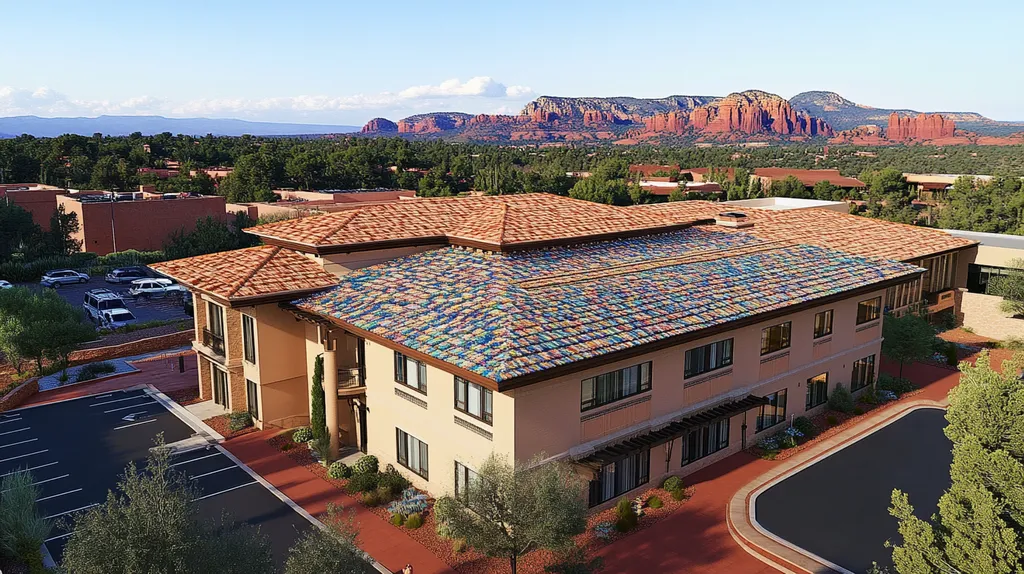As extreme weather events intensify across North America, commercial property owners face mounting pressure to fortify their roofing systems. Industry data reveals that weather-related roof damage has surged by 65% in the past decade, with repair costs averaging $250,000 per incident.
From hurricane-force winds to record-breaking snowfall, today’s roofs must withstand unprecedented challenges while maintaining energy efficiency and structural integrity.
This comprehensive guide examines critical factors in selecting and maintaining weather-resistant roofing systems, offering property professionals a strategic framework for evaluating options, managing costs, and ensuring long-term performance.
SECTION 1: PERFORMANCE FACTORS
As extreme weather patterns become the norm, the resilience of commercial roofing systems takes center stage. Property owners must grasp how factors like heavy winds, relentless rain, and scorching temperatures can jeopardize the structure of their roofs. The National Oceanic and Atmospheric Administration (NOAA) reports that major storms have surged in frequency over the last half-century. Assessing weather resistance, thermal performance, and load capacity is not just wise; it’s essential for safeguarding buildings and enhancing longevity.
Weather Resistance and Material Durability
When facing extreme weather, a roofing system’s ability to resist harsh elements is crucial. Roofs must stand strong against heavy rainfall, fierce winds, and possible hail damage. Materials like TPO (Thermoplastic Olefin) and PVC (Polyvinyl Chloride) are gaining popularity for their impressive resistance to UV rays and extreme temperatures.
Traditional asphalt roofs often fall short of the durability required in tougher conditions, leading to skyrocketing maintenance costs and safety risks. To ensure long-term resilience, materials must resist punctures and tears that could threaten the building’s integrity.
Furthermore, roof coatings can significantly bolster existing materials, adding an extra shield against severe weather. These coatings enhance durability while reducing concerns over leaks and water intrusion.
Key Action Items
Thermal Performance and Energy Efficiency
Energy efficiency plays a pivotal role in choosing a roofing system for extreme climates. Roofs that effectively manage temperature fluctuations can significantly cut down on energy costs while extending their lifespan. High-reflectivity materials, like cool-roof coatings, minimize heat absorption and are excellent for warmer regions.
In areas battling extreme heat, energy-efficient roofing can alleviate cooling costs, which tend to soar due to air conditioning demands. By contrast, well-insulated roofs keep heat in during colder months, leading to remarkable savings on heating expenses.
A thermally optimized roofing system enhances comfort for occupants and boosts overall building sustainability. Upgraded insulation standards, combined with modern materials, can lead to substantial energy consumption reductions.
Key Action Items
Structural Load Capacity for Extreme Events
Understanding a roofing system’s load capacity is critical, especially in areas susceptible to heavy snowfall or severe storms. These extreme conditions can strain a roof if it’s not equipped to bear the added weight. Reinforced structures and wind-resistant features are vital for ensuring safety and performance in harsh environments.
Commercial roofs must be designed to handle specific load requirements, factoring in both static loads and dynamic forces like wind uplift. Neglecting to assess these needs could result in disastrous roofing failures and pose risks to the safety of building occupants.
Regular inspections and structural evaluations are essential for ensuring compliance with current local building codes and ensuring peak performance during extreme weather. Investments in sturdy roofs are not just safeguarding buildings—they also protect lives.
Key Action Items
SECTION 2: FINANCIAL CONSIDERATIONS
Selecting the perfect roofing solution for extreme weather is more than a durability concern; it’s a financial game changer. Property owners must juggle upfront investment with long-term savings, making informed choices essential. With commercial roofs lasting anywhere from 15 to 50 years—according to the National Roofing Contractors Association—understanding the financial implications is critical. This section dives into initial costs, lifecycle expenses, and how insurance factors into your roofing decisions.
Initial Investment Versus Lifecycle Costs
Low upfront costs may tempt property owners when choosing roofing materials, but this short-sighted strategy can escalate long-term expenses. For instance, while traditional EPDM roofs are cheaper initially, their frequent repair needs can quickly add up.
Alternatively, investing in a more robust solution, like a metal roof, requires a higher initial investment but may last over 50 years, yielding significant savings down the line. Such choices can greatly affect budget planning and financial forecasts.
Thoroughly researching and comparing the total cost of ownership for various roofing options is vital. A well-rounded analysis helps anticipate future expenditures and make wise financial choices. Balancing initial outlay against lifecycle costs allows property managers to better evaluate long-term value and sustainability.
Key Action Items
Maintenance and Repair Cost Projections
Maintaining a roofing system is crucial, particularly in extreme weather conditions. Property owners should consider how the frequency and cost of maintenance will stack up against their roofing options. Failing to keep a roof in prime condition can lead to towering repair bills and a premature end to the roof’s useful life.
A flat roof, for example, tends to demand more frequent inspections and upkeep, which can inflate overall costs. In contrast, a sloped metal roof typically involves less maintenance, resulting in lower long-term expenses.
Establishing a solid maintenance plan is key, budgeting for routine inspections and repairs to enhance long-term roof health while minimizing emergency fixes. Utilizing predictive maintenance tools can also help forecast potential issues, paving the way for proactive budgeting and resource management.
Key Action Items
Insurance Impacts and Incentives
When evaluating roofing options for extreme weather, insurance impacts can’t be overlooked. Certain materials may qualify for reduced insurance premiums thanks to their durability and proven effectiveness against harsh elements. For example, reinforced PVC membranes offer impressive hail resistance, which could lead to lower insurance costs.
On the flip side, opting for lower-quality materials might result in higher premiums, as insurers assess increased risks connected to possible damage. Property owners would be wise to investigate incentives or discounts for roofs built to endure extreme conditions.
In addition, a comprehensive insurance policy that addresses the unique risks tied to specific locations and roof types is essential for safeguarding financial investments. Insurers often have resources to assist owners in selecting materials that can enhance risk profiles while minimizing the occurrence of covered claims.
By leveraging insurance insights, property owners can unlock significant savings, making it crucial to recognize the relationship between roofing choices and insurance impacts.
Key Action Items
SECTION 3: COMPLIANCE REQUIREMENTS
Navigating compliance requirements is essential for property owners dealing with extreme weather challenges. Ignoring regulations can lead to costly financial penalties and repair expenses. Surprisingly, over 60% of commercial roofing failures stem from non-compliance with local building codes and standards. This section emphasizes critical compliance areas, including local building codes, industry certifications, and environmental regulations, ensuring that roofs are both resilient and legally sound.
Local Building Codes and Weather Standards
Local building codes are vital when selecting roofing materials that can withstand extreme weather events. These codes reflect the unique climate conditions of different regions, ranging from hurricanes to heavy snowfall. Property owners and facility managers should thoroughly understand the specific codes applicable to their area.
Not complying with these regulations can lead to structural damage and hefty legal fines. For instance, properties in hurricane-prone zones must have roofs rated for high wind speeds to avoid disaster. Adhering to these standards often requires collaboration with local authorities during installation.
In addition, regular inspections and certifications may be necessary to maintain compliance, promoting continual safety and performance checks. Engaging knowledgeable roofing contractors can simplify this process, as they are familiar with local codes and can guide property managers through material selection.
Key Action Items
Industry Certifications and Material Approvals
Industry certifications are crucial in assuring that roofing materials can handle severe weather. Organizations like the American Society for Testing and Materials (ASTM) set testing standards to ensure product performance. Property owners should prioritize roofing systems that have been certified by reputable organizations.
Using untested materials can jeopardize the long-term durability and safety of roofs. For instance, TPO and PVC membranes lacking proper certifications may not perform well under extreme conditions, leading to leaks and significant repair costs. Always inquire about certifications when choosing materials to ensure they meet or exceed industry benchmarks.
Many manufacturers also provide warranties for certified products, offering an additional layer of security for property owners. Collaborating with certified roofing contractors ensures that materials and installations meet the highest standards of compliance and performance.
Key Action Items
Environmental and Sustainability Regulations
Environmental regulations are becoming increasingly influential in roofing choices, particularly in areas prone to extreme weather. Sustainable roofing solutions not only meet these regulations but can also lead to long-term financial savings. For example, energy-efficient roofing can significantly cut cooling costs in hot climates.
Failing to adhere to environmental standards may result in fines and reduce a property’s marketability. Many jurisdictions are now requiring sustainable materials, such as cool roofs, to mitigate urban heat islands and promote biodiversity. Property owners should compare roofing options against these sustainability criteria.
Moreover, opting for environmentally friendly materials can make properties more appealing to tenants who prioritize sustainability. This approach allows property owners to embrace compliance while enjoying the added benefit of potentially higher rental rates. Environmental consultants can aid in navigating these complex regulations and identifying suitable roofing options.
Key Action Items
SECTION 4: RISK MANAGEMENT
Extreme weather brings substantial risks that can jeopardize commercial roofing systems, putting both the structure and its valuable contents at risk. With the National Oceanic and Atmospheric Administration (NOAA) citing a 30% increase in severe weather events over the last decade, it’s essential for property owners and facility managers to be proactive. Identifying potential hazards and assessing vulnerabilities is vital for implementing effective damage control strategies.
Hazard Identification and Vulnerability Assessment
To kick off risk management, it’s crucial to identify hazards rooted in the geographical area. Property owners need to reflect on the types of extreme weather they regularly experience—think hurricanes, snowstorms, and torrential rain. Each of these presents unique risks that must be addressed.
A vulnerability assessment probes the weaknesses in existing roofing materials and systems. For example, flat roofs may face challenges from heavy snow loads if they lack adequate structural support. It’s wise to engage roofing consultants to pinpoint specific vulnerabilities and prioritize necessary upgrades.
Regularly updating documentation on potential hazards helps keep pace with climate changes and improves readiness for new roofing technologies.
Key Action Items
Emergency Response and Damage Mitigation
When extreme weather strikes, having a robust emergency response plan is critical for minimizing damage. Clear communication lines among all stakeholders involved in maintenance and repair are foundational.
Forming a rapid response team allows property managers to react promptly as severe weather unfolds. This team should be trained to implement pre-planned procedures that can effectively mitigate roof damage.
Investing in protective measures, such as tarps and sandbags, is vital for reducing damage severity. Regular emergency drills are advisable to ensure everyone knows their specific roles during a crisis.
Documenting all damage immediately after an event is essential for smooth insurance claims and aids in future preventive efforts.
Key Action Items
Warranty Coverage and Contractor Reliability
The reliability of roofing contractors is a key element in effective risk management. Property managers should prioritize finding contractors who offer warranties that specifically cover extreme weather circumstances.
Comprehensive warranties grant peace of mind, assuring property owners that their investment is safeguarded. Understanding warranty specifics—in particular, coverage related to storm and snow damage—is vital.
Comparing contractor reliability can be made easier through industry reviews and recommendations. Contractors with a history of successful projects under extreme weather conditions are invaluable assets.
Choosing a contractor who is tuned into local weather patterns can lead to roofing solutions customized for specific challenges.
Key Action Items
SECTION 5: OPERATIONAL PROCEDURES
When extreme weather conditions strike, operational procedures are essential for preserving the integrity of commercial roofs. Clear inspection and maintenance protocols can prevent costly damage and enhance safety. A proactive inspection strategy not only shortens recovery times but also reduces risks associated with weather events. This section delves into the importance of routine inspections, maintenance scheduling, and staff training in protecting roofing systems.
Routine Inspection and Weather-Impact Monitoring
Routine inspections are your first line of defense against weather-related damage. Property owners should schedule inspections at least twice a year, especially in regions prone to extreme weather. This proactive strategy allows for early identification of vulnerabilities, such as worn membranes or compromised flashing.
Monitoring weather impacts involves keeping abreast of forecasts and using data analytics to predict potential roofing challenges. For example, drone technology can quickly assess roof conditions before and after major storms.
By conducting regular inspections, property owners can facilitate timely repairs, preventing minor issues from escalating into catastrophic failures. An effective combination of weather monitoring with inspection schedules can optimize resources and enhance maintenance strategies as well.
Key Action Items
Roof Maintenance Scheduling and Prioritization
Effective maintenance scheduling is key to extending the lifespan of commercial roofs. Prioritizing high-risk areas vulnerable to extreme weather should be the focus; edges and corners often suffer first during high winds.
Regular maintenance tasks should encompass cleaning debris, resealing seams, and ensuring drainage systems are functional. Focusing on these actions can help prevent water accumulation, greatly reducing the risk of leaks and structural issues.
By adopting a systematic approach to maintenance, property owners can better allocate resources and budget for necessary upgrades or repairs. Each maintenance cycle also offers an opportunity to evaluate the roof’s resilience against changing weather patterns.
Key Action Items
Staff Training and Safety Protocols
Proper training and safety protocols for staff are crucial for successful roof management. A knowledgeable team will recognize potential hazards during inspections and maintenance tasks. Training should cover identifying damage signs and understanding how weather events affect roofing systems.
Implementing safety protocols ensures that team members use the proper protective gear and adhere to safe operating procedures. For example, guidelines for roof access during severe weather can prevent accidents and injuries.
Providing ongoing education about the latest roofing technologies and materials enables staff to make informed decisions during repairs. This knowledge empowers teams to adopt best practices that protect the roof while maintaining operational efficiency.
Key Action Items
SECTION 5: OPERATIONAL PROCEDURES
When extreme weather hits, operational procedures become vital for protecting the integrity of commercial roofs. Well-structured inspection and maintenance protocols can prevent costly damages and ensure safety across the board. Imagine the peace of mind a proactive inspection strategy provides—it not only shortens recovery times but also mitigates risks tied to delayed responses during severe weather events. This section highlights the critical importance of routine inspections, maintenance scheduling, and staff training in guarding roofing systems.
Routine Inspection and Weather-Impact Monitoring
Routine inspections are your frontline defense against weather-related damage. Property owners should schedule inspections at least twice a year, with more frequent checks in areas prone to extreme weather. This proactive approach allows for early detection of vulnerabilities, like worn membranes or compromised flashing.
Adding weather-impact monitoring means staying updated on forecasts and utilizing data analytics to anticipate potential roofing issues. For instance, drone technology can be an asset, providing quick assessments of roof conditions before and after significant storms.
Regular inspections not only help with timely repairs but also stop minor issues from escalating into major catastrophes. By setting a consistent inspection schedule, property owners can stay ahead of common roofing problems, optimizing both maintenance and longevity of the roof.
Key Action Items
Roof Maintenance Scheduling and Prioritization
Effective maintenance scheduling is the key to extending the lifespan of commercial roofs. Prioritizing high-risk areas vulnerable to extreme weather is essential. For example, the edges and corners are often the first to succumb to damage during high winds.
Regular maintenance tasks should include cleaning debris, resealing seams, and checking drainage systems for functionality. Staying on top of these practices can prevent water accumulation, drastically reducing the risk of leaks and structural complications.
By developing a systematic approach to maintenance, property owners can allocate resources wisely and budget effectively for upgrades or repairs. Each maintenance phase not only addresses current conditions but also offers an opportunity to assess the roof’s resilience against changing weather patterns.
Key Action Items
Staff Training and Safety Protocols
Training and safety protocols for staff are crucial to effective roof management. A knowledgeable team can spot potential hazards during inspections and maintenance tasks. Training should encompass how to recognize damage signs and understand how weather events impact roofing systems.
Implementing safety protocols ensures team members have access to the proper protective gear and adhere to safe work procedures. For example, establishing guidelines for roof access during severe weather conditions can greatly reduce the risk of accidents and injuries.
Ongoing education about the latest roofing technologies and materials empowers staff to make informed decisions during repairs. This foundational knowledge encourages the adoption of best practices that protect the roof while maintaining operational efficiency.
Key Action Items
Looking Ahead
As extreme weather events continue to intensify, with damage costs surging 300% in the past decade, commercial property owners face mounting pressure to fortify their roofing systems against unprecedented challenges.
The selection of weather-resistant materials, coupled with rigorous maintenance protocols, can mean the difference between minor repairs and catastrophic failures costing upwards of $500,000.
Success hinges on three critical factors: implementing comprehensive inspection schedules, investing in certified weather-resistant materials, and maintaining detailed documentation of all roofing activities.
Property owners who take decisive action now – upgrading materials, enhancing maintenance protocols, and training staff effectively – position themselves to better weather the storms ahead while protecting their substantial roofing investments.
The future of commercial roofing lies not just in reactive measures, but in proactive strategies that anticipate and adapt to our changing climate reality.
FREQUENTLY ASKED QUESTIONS
Q. How can I evaluate the weather resistance of my commercial roof?
A. Start by inspecting the materials used and their ratings against wind and rain. Research options like TPO or PVC, which offer robust protection under extreme conditions. Regular checks for damage, punctures, or wear will also help evaluate overall weather resistance.
Q. What are key financial considerations for an industrial roof?
A. Compare initial investment with long-term maintenance costs and energy efficiency savings. Research durable materials with lower lifecycle expenses, and consider financing options to manage larger upfront expenses. Thorough analysis ensures wise financial decisions that maximize value over your roof’s lifespan.
Q. How can I ensure my commercial roof meets compliance requirements?
A. Familiarize yourself with local building codes and weather standards. Regularly engage certified contractors for inspections, and document compliance efforts diligently to avoid penalties and ensure safety. Stay updated on changes in regulations and ensure all materials meet the necessary certifications.
Q. What steps should I take for effective risk management of my roof?
A. Begin with identifying local weather hazards and conducting vulnerability assessments of your roofing materials. Create an emergency response plan, and regularly engage in preventive maintenance and drills. This proactive approach will help minimize potential damage during extreme weather events.
Q. How important are routine inspections for commercial roofs?
A. Routine inspections are crucial for catching potential problems early. Schedule at least semi-annual inspections to identify vulnerabilities like damaged membranes before they lead to costly repairs. Combine these inspections with weather-impact monitoring to optimize maintenance strategies and protect your investment.
Q. Why is staff training essential for roofing management?
A. Proper training equips your team to spot roofing hazards and implement effective maintenance. Safety protocols minimize risks during inspection and repair work. Continual education about evolving roofing technologies empowers staff to make informed decisions that protect the roof’s longevity.
Q. What types of materials are ideal for extreme weather conditions?
A. Consider materials like metal roofing, TPO, or PVC that provide superior durability and weather resistance. These materials can withstand hail, high winds, and extreme temperatures, ensuring your roof remains intact and functional during severe weather events.

